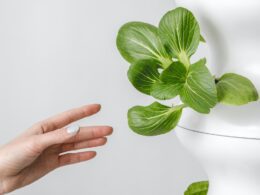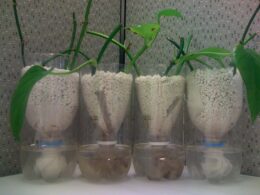Are you considering growing hydroponic tomatoes? While hydroponic farming offers many benefits, there are also some potential problems to consider.
One potential problem with hydroponic tomatoes is the risk of disease. Because hydroponic tomatoes are grown in a soilless environment, they may be more susceptible to certain diseases that thrive in moist conditions. Additionally, because hydroponic systems are often used in indoor environments, there may be less natural air circulation and sunlight, which can create ideal conditions for fungal and bacterial growth.
However, with proper care and attention to sanitation and environmental conditions, it is possible to minimize the risk of disease and produce healthy, delicious hydroponic tomatoes.
Disease Risk in Hydroponic Tomatoes
Disease can be a major risk in growing these succulent fruits in a hydroponic system. Without soil acting as a natural barrier, hydroponic tomatoes are more vulnerable to diseases. In a closed hydroponic system, pests can easily spread from plant to plant, making pest management crucial.
Environmental factors also play a role in the risk of disease in hydroponic tomatoes. High humidity levels and warm temperatures create an ideal environment for fungal growth. Water quality is another important factor to consider, as contaminated water can spread disease throughout the entire hydroponic system.
To mitigate the risk of disease in hydroponic tomatoes, it’s important to maintain a clean and sanitary growing environment. This includes properly cleaning and disinfecting equipment, monitoring and maintaining proper humidity levels, and regularly testing water quality.
Additionally, implementing a pest management plan can help prevent the spread of pests and disease. By taking these precautions, you can help ensure the health and safety of your hydroponic tomato crop.
Nutrient Deficiencies in Hydroponic Tomatoes
Lack of essential nutrients can hinder the growth and yield of hydroponic tomatoes, but it is possible to prevent deficiencies and ensure healthy plants. Here’s how:
-
Monitor pH levels regularly. Ideally, the pH should be between 5.5 and 6.5 for hydroponic tomatoes. Anything outside of this range can prevent the plant from absorbing essential nutrients.
-
Use a balanced nutrient solution. Provide a nutrient solution that contains the right balance of macronutrients and micronutrients. This will help prevent deficiencies and promote healthy growth.
-
Adjust nutrient levels as needed. Over time, nutrient levels can change. Monitor them regularly and adjust as needed to prevent deficiencies.
-
Consider supplementing with beneficial microbes. Beneficial microbes can help improve nutrient uptake and prevent deficiencies. Add a microbial supplement to your hydroponic system to promote healthy growth.
By following these steps, you can ensure your hydroponic tomatoes are healthy and productive. Monitor pH levels regularly, use a balanced nutrient solution, adjust nutrient levels as needed, and consider supplementing with beneficial microbes. With these strategies in place, you can enjoy a bountiful harvest of juicy, flavorful tomatoes.
Are the Problems with Hydroponic Lettuce Similar to Hydroponic Tomatoes?
The problem with hydroponic lettuce differs from that of hydroponic tomatoes due to their varying growth patterns. While hydroponic lettuce is prone to issues like root rot and nutrient deficiencies, hydroponic tomatoes face challenges like blossom end rot and inadequate pollination. Each plant necessitates distinct care and attention in hydroponic cultivation.
Benefits of Hydroponic Farming for Tomato Production
Growing tomatoes hydroponically offers numerous advantages, such as increased control over growing conditions and improved efficiency in water and nutrient usage. With vertical farming, hydroponic tomato growers can maximize the use of space and resources, making it a sustainable agriculture option.
Hydroponic systems also eliminate the need for pesticides and herbicides, reducing the risk of chemical contamination in the produce. In addition to being a sustainable and safe option, hydroponic farming for tomato production also offers improved yields and faster growth rates. Since nutrients are delivered directly to the plant’s roots, they can absorb them more readily, resulting in healthier and more robust plants.
Furthermore, hydroponic systems can be set up indoors, allowing for year-round cultivation and protection from harsh weather conditions. Overall, hydroponic farming is an efficient and effective way to grow tomatoes. With vertical farming, sustainable agriculture practices, and control over growing conditions, hydroponic tomato growers can produce high-quality produce in a safe and eco-friendly manner.
As the demand for locally sourced, fresh produce continues to grow, hydroponic farming is poised to become an increasingly popular option for farmers and consumers alike.
Best Practices for Hydroponic Tomato Farming
To maximize your yield and ensure the success of your tomato crop, it’s important to implement certain techniques and strategies when farming using a hydroponic system.
One of the best practices for hydroponic tomato farming is to use vertical farming techniques. This method maximizes space and allows for more plants in a smaller area. It also allows for better control over the plant’s growth and exposure to light.
Another important practice is to maintain sustainable agriculture. This means using organic growing practices and avoiding the use of harmful chemicals. It also means being mindful of water usage and recycling water as much as possible. This not only benefits the environment but also results in healthier and more flavorful tomatoes.
Lastly, it’s crucial to pay attention to the pH levels and nutrient levels in the water. Hydroponic systems require precise monitoring and adjustments to ensure that the plants are receiving the correct nutrients. This can be done through regular water testing and using a nutrient solution that is tailored to the specific needs of tomato plants.
By implementing these best practices, you can ensure a successful and sustainable hydroponic tomato crop.
Future of Hydroponic Farming for Tomato Production
The future of farming juicy and flavorful tomatoes looks bright with the innovative techniques and sustainable practices being developed. Vertical farming, for example, allows for more efficient use of space as crops are grown in stacked layers. This is especially useful for urban agriculture, where space is limited and demand for fresh produce is high.
With this method, hydroponic tomatoes can be grown year-round in controlled environments, reducing the risk of crop failure due to weather or pests. In addition to vertical farming, advancements in technology have allowed for more precise control over growing conditions. This includes the use of sensors and automation to monitor and adjust factors such as temperature, humidity, and nutrient levels in real-time.
This not only improves crop yields, but also reduces waste and conserves resources such as water and energy. As hydroponic farming continues to evolve, it has the potential to revolutionize the way we grow and consume food. By growing crops in controlled environments, we can reduce the use of harmful pesticides and herbicides, and minimize the environmental impact of agriculture.
With the ability to grow fresh, nutritious produce year-round, regardless of location or climate, hydroponic farming offers a sustainable solution to feeding our growing population.
Frequently Asked Questions
What are the upfront costs of starting a hydroponic tomato farm?
Starting a hydroponic tomato farm requires some upfront costs, but vertical farming has made it more accessible and cost-effective. Instead of soil, nutrient solutions are used to grow the tomatoes, which eliminates the need for pesticides and herbicides, making it a safer option for consumers. The nutrient solution is constantly monitored to ensure the plants receive the necessary nutrients.
With vertical farming, space is maximized, and yields are increased. The initial investment may seem daunting, but the benefits of hydroponic tomato farming are worth it.
How does the taste of hydroponic tomatoes compare to traditionally grown tomatoes?
When it comes to the taste comparison between hydroponic tomatoes and traditionally grown tomatoes, there are mixed opinions. Some argue that hydroponic tomatoes lack the depth of flavor that comes from soil-grown tomatoes, while others claim that hydroponic tomatoes have a consistent, sweet taste.
However, one thing is certain: the nutritional value of hydroponic tomatoes is on par with traditionally grown tomatoes. In fact, hydroponic tomatoes are often richer in vitamins and minerals due to the controlled environment in which they are grown.
So, while taste may be subjective, you can rest assured that your hydroponic tomatoes will be just as nutritious as their soil-grown counterparts.
What precautions should be taken to prevent pests in a hydroponic tomato farm?
To protect your hydroponic tomato crop from pests, there are a few key precautions you should take.
First, regularly inspect your plants for signs of infestation, such as chewed leaves or webs. If you do spot pests, act quickly to remove them manually or with an organic insecticide.
Additionally, consider using biological control methods, such as introducing beneficial insects like ladybugs or lacewings.
It’s also important to practice good hygiene, including cleaning your equipment and removing any dead plant matter, as this can attract pests.
By taking these steps, you can ensure your hydroponic tomatoes stay healthy and free from pests, allowing you to enjoy a bountiful harvest.
Can hydroponic tomatoes be certified organic?
If you’re wondering whether hydroponic tomatoes can be certified organic, the answer is yes! To earn organic certification, hydroponic farmers must follow the same standards as soil-based farmers.
The main difference is that hydroponic farmers must use an approved organic growing medium instead of soil. While some argue that hydroponic farming lacks the natural diversity that soil-based farming offers, hydroponic farmers have found ways to mimic soil’s rich ecosystem by adding beneficial microbes to their nutrient solutions.
So, if you’re looking for organic tomatoes without the worry of soil contamination, hydroponic tomatoes may be a great option for you.
How does the yield of hydroponic tomatoes compare to traditionally grown tomatoes?
When it comes to comparing the yield of hydroponic tomatoes to traditionally grown tomatoes, there are a few factors to consider. One of the biggest advantages of hydroponic systems is that they allow for precise control over the nutrient solution that the plants receive. This means that hydroponic tomatoes have the potential to produce higher yields than traditionally grown tomatoes because they are receiving the exact nutrients they need to grow.
However, yield comparison is not always straightforward, as traditional farming methods also rely on factors such as soil quality and weather conditions. Despite this, many hydroponic growers report impressive yields and consistent crop quality.
So, if you’re looking for a reliable way to grow tomatoes with high yields, hydroponic systems with carefully calibrated nutrient solutions may be a good option to consider.
Conclusion
So, there you have it! Hydroponic tomato farming has its challenges, but it also offers some exciting solutions to traditional farming methods.
With careful attention to disease prevention and nutrient management, hydroponic tomatoes can be just as healthy and delicious as their soil-grown counterparts. In fact, many experts believe that hydroponic farming is the future of agriculture.
With a growing population and increasing demand for fresh, locally grown produce, the need for innovative farming techniques has never been greater. So, don’t be afraid to give hydroponic tomato farming a try.
With a little research and some hard work, you might just be surprised by the results!









